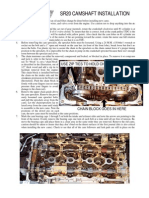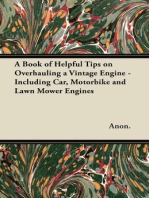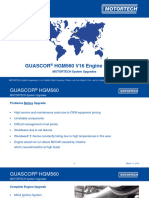Why Is It That Important
Why Is It That Important
Uploaded by
kozaro 678Copyright:
Available Formats
Why Is It That Important
Why Is It That Important
Uploaded by
kozaro 678Copyright
Available Formats
Share this document
Did you find this document useful?
Is this content inappropriate?
Copyright:
Available Formats
Why Is It That Important
Why Is It That Important
Uploaded by
kozaro 678Copyright:
Available Formats
Why Is It That Important?
The valve CLEARANCE WILL CHANGE after a good period of time when the camshafts, valve seats, and valves
wear in. This is very common on any engine with a rocker arm setup like the Toyota 20R and 22R/RE/RET motors in
Pickup trucks and 4Runners.
Valves adjustment is something nobody wants to do but, Toyota recommends they be checked every 60,000 miles.
The importance of checking and adjusting your valves resides in that if you have too much clearance it can quickly
cause destruction or extreme damage to your engine. Also if a valve is burnt and isn't sealing properly you aren't
getting a fully sealed combustion chamber. Sometimes valve adjustment is so out of specs, it hinders the
performance of the vehicle or is extremely noisy. Some symptoms of misadjusted valves are: pour gas mileage, lack
of power or excessive emissions, among others.
How To Adjust Your Valves?
Valve clearances: Intake=0.008" (0.2mm)
Exhaust=0.012" (0.3mm)
1. 1-Start the engine and allow it to reach normal operating temperature (required), then shut it off.
2. 2-Be really careful because everything will be extremely hot.
3. 3-Remove everything connected or on the way to the valve cover.
4. 4-Remove valve cover and distributor cap.
5. 5-Position the piston # 1 at TDC (Top Dead Center) on the compression stroke. That means the balancer
mark on the crankshaft pulley aligns with the 0 mark on the timing tag, at the same time the rotor on the distributor
has to point at # 1.
6. 6-Make sure the rocker arms for the # 1 cylinder valves are loose and # 4 are tight. If they are not, the # 1
piston is not at TDC on the compression stroke.
7. 7-Check/Adjust only the valves indicated by arrows in (illustration)
8-The clearance is measured by inserting the specified size feeler gauge between the end of the valve stem and the
adjusting screw. You should feel aslight amount of drag when the feeler gauge is moved back-and-forth.
1. 9-If the gap is too large or too small, loosen the locknut and turn the adjusting screw to obtain the correct
gap.
2. 10-Once the gap has been set, hold the screw in position with a screwdriver and retighten the locknut. Re-
check the valve clearance and make sure it did not changed when the locknut was being tightened. If so, re-adjust it
until it is correct.
3. 11-Repeat the procedure for the remaining valves (illustration 1), then turn the crankshaft one complete
revolution (360º) and realign the notch in the pulley with the zero on the engine.
4. 12-Adjust the valves indicated by arrows in this second picture.
13-Re-check Valve clearances and re-adjust if necessary.
1. 14-Reinstall the valve cover, distributor cap and reconnect all hoses and wiring.
2.
3. Valve Adjustment Tips:
*Valve clearance for aftermarket performance cams may vary. Follow cam manufacturer valve
clearance specifications.
*Inspect cam lobes for abnormal wear and valve adjusting screws for flat spots and pitting. If the
screws are worn, this will make your valve adjustment inaccurate.
You might also like
- Detroit s60 Valve Adjustment PDFDocument12 pagesDetroit s60 Valve Adjustment PDFDiego Monroy83% (6)
- 1955 Seagrave Model 530-BH ManualsDocument129 pages1955 Seagrave Model 530-BH Manualsbones333100% (3)
- Ricardo TutorialDocument147 pagesRicardo TutorialAbhimanyu Das75% (4)
- Volvo d12d Valve AdjustmentDocument7 pagesVolvo d12d Valve Adjustmentali78% (9)
- SUN Dwell / TachDocument8 pagesSUN Dwell / TachWongstorn DamrongmaneeNo ratings yet
- 3208 Engine Valve Lash CaterpillarDocument4 pages3208 Engine Valve Lash CaterpillarLuisMH100% (4)
- Valve Adjustment E7Document16 pagesValve Adjustment E7malcolm stewartNo ratings yet
- Picturelist Pricelist PDFDocument24 pagesPicturelist Pricelist PDFHOFFMAN STEINHOWERNo ratings yet
- BSVN 200Document40 pagesBSVN 200Fernando De Jesus0% (1)
- How To Change Deutz 1011Document11 pagesHow To Change Deutz 1011melaku100% (1)
- Instruction Manual: Hako-Trac 1950 DA (8084)Document62 pagesInstruction Manual: Hako-Trac 1950 DA (8084)Aleksandra HreščakNo ratings yet
- Repair Guides - Carbureted Fuel System - Rochester 2se - E2se CarburetorDocument5 pagesRepair Guides - Carbureted Fuel System - Rochester 2se - E2se CarburetoreducsalNo ratings yet
- 6bt Valve Lash PDFDocument7 pages6bt Valve Lash PDFmilNo ratings yet
- Valve, AdjustingDocument5 pagesValve, AdjustingHendry PardedeNo ratings yet
- 2016 - 06 - PeG (Overhauling Report of MAAG Gear by Peter Gunsch)Document10 pages2016 - 06 - PeG (Overhauling Report of MAAG Gear by Peter Gunsch)AamirKhanNo ratings yet
- Spare Parts List: Hydraulic BreakersDocument36 pagesSpare Parts List: Hydraulic BreakersSerkanAlNo ratings yet
- Valveadjustment PDFDocument2 pagesValveadjustment PDFNacer MalekNo ratings yet
- Ajuste de ValvulasDocument5 pagesAjuste de ValvulasAlejandro ValenzuelaNo ratings yet
- B Series Valve AdjustmentDocument5 pagesB Series Valve Adjustmentsasa oljacaNo ratings yet
- Waukesha F11gsi - Valve Clearence - CompressionDocument2 pagesWaukesha F11gsi - Valve Clearence - Compressionnicol_sg100% (1)
- Ajuste Valve Perins 1104Document5 pagesAjuste Valve Perins 1104josel204No ratings yet
- Trick Flow Camshaft Degreeing Kit: Instructions ForDocument4 pagesTrick Flow Camshaft Degreeing Kit: Instructions ForROYALNo ratings yet
- Valve — Clearance Adjustment - ctm104819 __ Service ADVISOR™Document3 pagesValve — Clearance Adjustment - ctm104819 __ Service ADVISOR™oconnorcustomsNo ratings yet
- Calibracion de Valvulas.Document3 pagesCalibracion de Valvulas.Enso RosalesNo ratings yet
- Cam Install For Sr20Document2 pagesCam Install For Sr20Carlos Miguel Montaño AlvarezNo ratings yet
- Removing Distributor AssemblyDocument2 pagesRemoving Distributor Assemblyzelalem mamoNo ratings yet
- PROPER VALVE LASH ADJUST_073124Document4 pagesPROPER VALVE LASH ADJUST_073124sansao luisNo ratings yet
- Camshaft / Lifters / Lube Kit CATALOG # 3702 General InstructionsDocument4 pagesCamshaft / Lifters / Lube Kit CATALOG # 3702 General InstructionsFREDDYJIMENEZNo ratings yet
- 1966 FORD MUSTANG Valve-Lash-Adjustment - CopieDocument2 pages1966 FORD MUSTANG Valve-Lash-Adjustment - CopieLudo BarthelemyNo ratings yet
- Edelbrock Camshaft 7102Document5 pagesEdelbrock Camshaft 7102v-techNo ratings yet
- Engine Cummins PDFDocument7 pagesEngine Cummins PDFArif Awan100% (1)
- Calibracion de Valvulas Perkins 400Document3 pagesCalibracion de Valvulas Perkins 400nolram23No ratings yet
- ZJ70DBS Drilling Rig NJ-15C2 Series Drilling Fluid Agitator User ManualDocument9 pagesZJ70DBS Drilling Rig NJ-15C2 Series Drilling Fluid Agitator User ManualAhmedNo ratings yet
- .Archivetempsection 13 - Engine Tune-UpDocument8 pages.Archivetempsection 13 - Engine Tune-UpFernando MirandaNo ratings yet
- Valve Adjustment ProcedureDocument1 pageValve Adjustment ProcedureKim Tuazon SantosNo ratings yet
- BandasDocument116 pagesBandasJhon GuerraNo ratings yet
- Camry Timing BeltDocument2 pagesCamry Timing BeltsharemwNo ratings yet
- 2001 Chevy S10 T10 Blazer Distributor Replacement REMOVAL PROCEDUREDocument7 pages2001 Chevy S10 T10 Blazer Distributor Replacement REMOVAL PROCEDUREKidd50% (2)
- Maintenance and Repair InstructionsDocument12 pagesMaintenance and Repair InstructionsDhananjay NilkuteNo ratings yet
- Valve Adjustment PDFDocument34 pagesValve Adjustment PDFlilo6romeroNo ratings yet
- Camshaft Install Qr25de InstructionsDocument3 pagesCamshaft Install Qr25de InstructionsmehralsmenschNo ratings yet
- DIY - Replacing Timing BeltsDocument3 pagesDIY - Replacing Timing Beltstron68bizz100% (2)
- Honda Civic 99 Banda de DistribuicionDocument10 pagesHonda Civic 99 Banda de DistribuicionRuben CruzNo ratings yet
- Caterpillar Вмт и Клапаны 3066Document5 pagesCaterpillar Вмт и Клапаны 3066Евгений АбрамовNo ratings yet
- Valves, AdjustingDocument9 pagesValves, AdjustingNasrul arulNo ratings yet
- Valve LashDocument5 pagesValve LashDedy hermawanNo ratings yet
- Carbtune PDFDocument22 pagesCarbtune PDFndmvillocilloNo ratings yet
- Farm Power PracticalDocument5 pagesFarm Power PracticalSaliha SattiNo ratings yet
- How - To Engine Tune-Up BasicsDocument6 pagesHow - To Engine Tune-Up Basicsimplode32No ratings yet
- Valve Adjustment ProcedureDocument24 pagesValve Adjustment ProcedureRoel Bautista100% (1)
- Hyundai Exel 89 1.5l.mantenimientoDocument18 pagesHyundai Exel 89 1.5l.mantenimientoAlexander cesar neyra sotoNo ratings yet
- ECU Board VTEC Conversion KitDocument11 pagesECU Board VTEC Conversion KitsdwsedNo ratings yet
- Marine Engineering PracticeDocument19 pagesMarine Engineering PracticeAnoop Vijayakumar100% (1)
- Valve Lash Adjustment Sullair Engine C4Document3 pagesValve Lash Adjustment Sullair Engine C4Rommy SudarnoNo ratings yet
- Aeaf Lab ManualDocument40 pagesAeaf Lab ManualvairamNo ratings yet
- Hyundai Coupe 2.0Document11 pagesHyundai Coupe 2.0BrandonHiDudNo ratings yet
- Valve Adjustment 2001 Honda CivicDocument34 pagesValve Adjustment 2001 Honda Civicjohn macsterNo ratings yet
- Fuel Injection Timing: Engine Setup and AdjustmentsDocument28 pagesFuel Injection Timing: Engine Setup and AdjustmentsDaniel PaisNo ratings yet
- Iom DSM100-36Document27 pagesIom DSM100-36rogueatdoor100% (1)
- The Book of the Singer Junior - Written by an Owner-Driver for Owners and Prospective Owners of the Car - Including the 1931 SupplementFrom EverandThe Book of the Singer Junior - Written by an Owner-Driver for Owners and Prospective Owners of the Car - Including the 1931 SupplementNo ratings yet
- A Book of Helpful Tips on Overhauling a Vintage Engine - Including Car, Motorbike and Lawn Mower EnginesFrom EverandA Book of Helpful Tips on Overhauling a Vintage Engine - Including Car, Motorbike and Lawn Mower EnginesRating: 5 out of 5 stars5/5 (1)
- Caring for your scooter: How to maintain & service your 49cc to 125cc twist & go scooterFrom EverandCaring for your scooter: How to maintain & service your 49cc to 125cc twist & go scooterNo ratings yet
- Plymouth and Chrysler-built cars Complete Owner's Handbook of Repair and MaintenanceFrom EverandPlymouth and Chrysler-built cars Complete Owner's Handbook of Repair and MaintenanceNo ratings yet
- Land Rover Series I-III: Your expert guide to common problems & how to fix themFrom EverandLand Rover Series I-III: Your expert guide to common problems & how to fix themNo ratings yet
- Class Test 2 DOTSDocument1 pageClass Test 2 DOTSGanesh ShankarNo ratings yet
- Elec AnswersDocument4 pagesElec Answerskenoop07No ratings yet
- MOTORTECH Presentation Upgrade GUASCOR HGM560 EN 2019 03Document25 pagesMOTORTECH Presentation Upgrade GUASCOR HGM560 EN 2019 03delson ferreiraNo ratings yet
- Isuzu Engine Diagnostics PDFDocument2 pagesIsuzu Engine Diagnostics PDFJorge R RojasNo ratings yet
- Chapter Thirteen: Nose Wheel Steering SystemsDocument5 pagesChapter Thirteen: Nose Wheel Steering SystemsAnonymous pxy22mwps5No ratings yet
- Diagnostic List GREAT WALL MOTOR - : Page 1 of 18Document18 pagesDiagnostic List GREAT WALL MOTOR - : Page 1 of 18Henry RomeroNo ratings yet
- ENG-1 INSP050-PW6000 BORESCOPE INSPECTION - RevisedDocument15 pagesENG-1 INSP050-PW6000 BORESCOPE INSPECTION - RevisedcoordbiancoazultecNo ratings yet
- Multibody Analysis of The Desmodromic Valve TrainDocument14 pagesMultibody Analysis of The Desmodromic Valve TrainIkshwakNo ratings yet
- Catalogue Tractopelle 315 SJDocument594 pagesCatalogue Tractopelle 315 SJRodriguez José Fils100% (1)
- Sauter B6R Three-Way Valve With Female Thread, PN 16Document4 pagesSauter B6R Three-Way Valve With Female Thread, PN 16pitanje1991No ratings yet
- Manual de Rendimiento 2000 ED 31 (BIS)Document11 pagesManual de Rendimiento 2000 ED 31 (BIS)Jairo AcostaNo ratings yet
- Chery Carry A18 ENGINE ELECTRICAL SYSTEM - E PDFDocument89 pagesChery Carry A18 ENGINE ELECTRICAL SYSTEM - E PDFEduar SevillaNo ratings yet
- Vertical Section @sat EditDocument1 pageVertical Section @sat EditssNo ratings yet
- CONVERGE BibliographyDocument6 pagesCONVERGE BibliographyabeytofirkyaluNo ratings yet
- 2ad100d B05oa1 As03 B2NQ 3 Phase Inducion Motor Rexroth Indramat ManualDocument134 pages2ad100d B05oa1 As03 B2NQ 3 Phase Inducion Motor Rexroth Indramat ManualRGNo ratings yet
- The Second Law of Thermodynamics: Refrigerators EntropyDocument33 pagesThe Second Law of Thermodynamics: Refrigerators EntropyKristine Rodriguez-CarnicerNo ratings yet
- MS4104, MS4109, MS4604, MS4609, MS8104, MS8109 Fast-Acting, Two-Position ActuatorsDocument8 pagesMS4104, MS4109, MS4604, MS4609, MS8104, MS8109 Fast-Acting, Two-Position ActuatorscauvongkhongmauNo ratings yet
- Fokker 50-Bleed Air SystemDocument8 pagesFokker 50-Bleed Air SystemDVSNo ratings yet
- Deutz F3M 2011ext - enDocument4 pagesDeutz F3M 2011ext - enAhmed ZeharaNo ratings yet
- ATLAS Z KitsDocument13 pagesATLAS Z KitsRoberto ZevallosNo ratings yet
- 2.4 Brayton CycleDocument12 pages2.4 Brayton Cyclehhjq6gtdbgNo ratings yet
- Unit 3 PumpsDocument28 pagesUnit 3 PumpsarunlaltpNo ratings yet
- Engine Management: Knock SensorDocument2 pagesEngine Management: Knock SensorVenelin KostadinovNo ratings yet

























































































